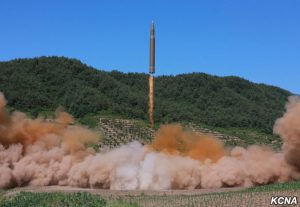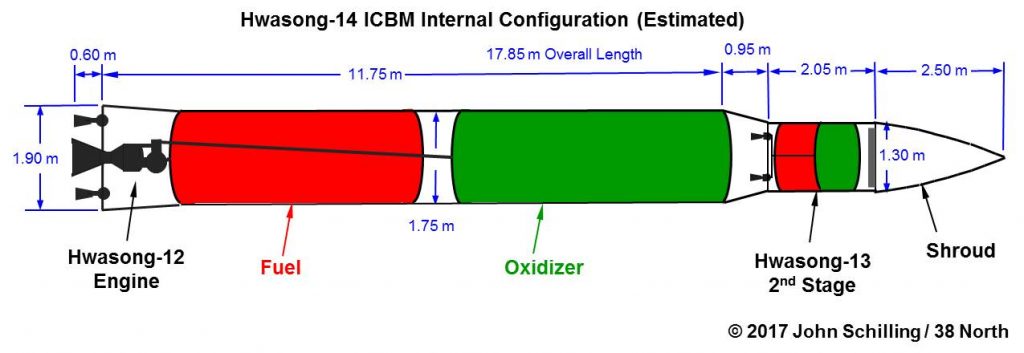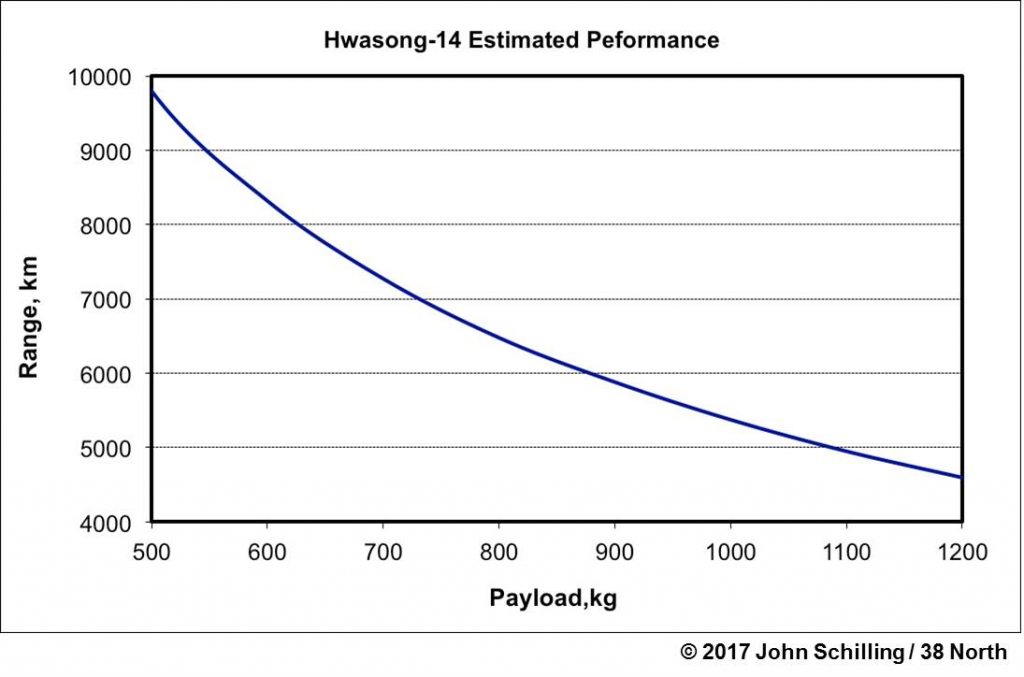What is True and Not True About North Korea’s Hwasong-14 ICBM: A Technical Evaluation

After the frenzy of technical speculation over the successful launch of North Korea’s Hwasong-14 intercontinental ballistic missile (ICBM), the dust seems to be clearing and the emerging reality is that the North has an unreliable missile that can reach Alaska or Hawaii with a single nuclear warhead, and would be lucky to hit even a city-sized target. However, with a year or two of additional testing and development, it will likely become a missile that can reliably deliver a single nuclear warhead to targets along the US west coast, possibly with enough accuracy to destroy soft military targets like naval bases. In perhaps five years, North Korea may be able to incorporate a modest suite of decoys and penetration aids to challenge US missile defenses. Let’s hope US missile defenses are up to that challenge.
Contrary to the assertions of some analysts that the missile is currently capable of carrying several warheads, not just one, it may eventually be able to carry a modest suite of decoys or penetration aids, though probably not for several years. A multiple warhead capability, while theoretically possible, would require a very lightweight warhead, which will require a lot more nuclear testing and is probably a decade in the future at best.
That said, the Hwasong-14 that flew last week was surprising in several respects. On the surface, it appeared to be a completely different missile than the one North Korea rolled out under the name of “Hwasong-14” back in 2015. On close examination, however, this new Hwasong-14 appears to be closely based on elements of several previous North Korean missiles. In fact, very little of the Hwasong-14 is truly new: it uses the same engine as the Hwasong-12, a structural technology first developed for the original Hwasong-14 and demonstrated on the Hwasong-12; it also featured an upper stage very similar in size and performance to the Hwasong-13 (itself derived from the upper stage of the Unha space launch vehicle), and probably a reentry vehicle (RV) derived from the original Hwasong-14. An estimate of how all these parts come together is shown below.

It is surprising, nonetheless, that North Korea was able to make last week’s test look like a new missile by using technologies and systems they have been working with in other contexts for years. This means we can make a reasonable estimate of its performance by looking at those other systems, and comparing what we know about them to what the Hwasong-14 demonstrated last week. As was noted at the time, the Hwasong-14 was launched on a very high angle “lofted” trajectory to avoid overflying Japan, and might have reached a distance of 7,000-8,000 kilometers if launched on a maximum-range trajectory. If the Hwasong-14 is put together the way we think it is, it can probably do a bit better than that when all the bugs are worked out. The figure below shows the estimated reach of a fully developed Hwasong-14 as a function of payload weight, with the missile fired in a northeast direction from North Korea. The North Koreans won’t be able to achieve this performance tomorrow, but they likely will eventually.

A range of as much as 9,700 kilometers, approximately the distance from North Korean launch sites to the US naval base at San Diego, would be possible with a 500 kg payload. And that raises an obvious question: what is that payload? Most every other North Korean long-range missile is topped with a triconic reentry vehicle sized for a single nuclear warhead about the size of the mock-up Kim Jong Un showed off last year. We’re pretty sure North Korea can actually build nuclear warheads about that size. But where other missiles have visible reentry vehicles, the Hwasong-14 has a detachable payload shroud.[1] We don’t know what goes inside, except that the usual triconic reentry vehicle won’t fit.
Those reentry vehicles probably aren’t qualified for reentry at ICBM velocities, and changing that would require an extensive test program. A faster and lower-risk approach to putting a warhead on an ICBM is to use a blunt-body reentry vehicle, like the United States did on its first Thor and Atlas ICBMs. And indeed, the original Hwasong-14 missile from 2015 sported a blunt-body RV at the tip—one that would fit almost perfectly inside the new Hwasong-14’s shroud. Blunt-body RVs have their disadvantages, such as limited accuracy. But, as long as you’re willing to settle for landing within a few miles of the target, they will do the work.
In the short term, that’s probably all there is to it—a streamlined fairing over a blunt-body RV, capable of delivering a 500 to 600 kg nuclear payload with limited accuracy to targets on the US west coast. In the longer term, however, there may be something more. Payload shrouds are somewhat failure-prone until they have been thoroughly tested, and usually not worth the bother if all one wants to do is deliver a single warhead. Payload shrouds are designed to provide a clean aerodynamic exterior to a complex assortment of un-aerodynamic payloads.
Thus, we expect there will eventually be more than just a single warhead under the shroud. But it probably won’t be multiple warheads, at least not for a decade or more. Multiple warheads of the size North Korea has displayed and can plausibly build today, along with reentry vehicles to carry them, simply wouldn’t fit. To put multiple warheads inside that fairing, at a weight that would still allow intercontinental reach, North Korea would have to develop a lightweight nuclear warhead comparable to the W-68 warhead of the US Poseidon missile. It took the United States almost 15 years to go from building the sort of nuclear weapons North Korea has today to the W-68. And while the North Korean missile program has been conducting tests at an accelerated pace, they have conducted only two nuclear tests in the past four years. So perhaps in 2030 we will see a multiple-warhead Hwasong-14, but probably not before then.
A more urgent, and more realistic, priority for North Korea would be a system of decoys and penetration aids to defeat US missile defenses. The US national missile defense system in its current state is limited and unreliable, working only about half the time in tests. But North Korea has to consider that deploying an operational ICBM would motivate the United States to improve its defenses. They can’t possibly hope to build more ICBMs than the US can build missile defense interceptors. But if they can put a dozen or so effective decoys on each missile—that might be enough to maintain a credible deterrent.
This is not a trivial matter. One often hears decoys described as “mylar ballons,” as if a simple child’s toy would be sufficient. In reality, a toy balloon probably wouldn’t survive the harsh environment of a missile launch, let alone fool a sophisticated adversary’s defense. As a more realistic example, consider the British “Chevaline” decoy system, developed using the technology of the early 1970s when the United Kingdom faced a similar deterrence credibility problem against Russia’s nascent anti-ballistic missile (ABM) system. This is a capability North Korea could reasonably hope to match.
It took the UK seven years and seven billion (in current year dollars) to make Chevaline work. The system reportedly shoehorned 27 decoys and their deployment mechanisms into slightly more than 250 kilograms. That’s half the payload of the Hwasong-14, if North Korea is serious about targeting San Diego. Consequently, the North Koreans would probably have to accept a reduced decoy count, and make some progress on warhead weight reduction, to make it all fit. I would be very surprised if they weren’t working on that already, but without a missile to work with, there is a limit to how much progress they can make.
- [1]
A payload shroud is a hollow aerodynamic fairing at the front end of a rocket or missile, typically enclosing a payload with poor aerodynamic properties and jettisoned as soon as the missile has left the atmosphere.
